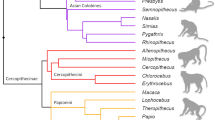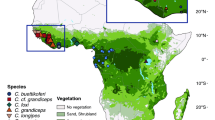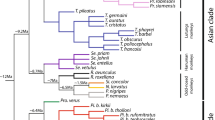Abstract
The impact of environmental variation on phenotypic diversification is one major issue in evolutionary studies. Environmental variation is thought to be a primary factor in evolution, especially at high latitudes. In contrast, tropical areas are traditionally viewed as the cradle where the long-term effects of biological interactions on phenotypic change reside. We analyse patterns of skull shape variation in two New World monkey groups: capuchins and howlers. These two monophyletic clades are exceptionally similar in terms of the geographic distribution of their species. Yet, their body size and diet are different: howler monkeys are large and almost exclusively folivorous, whereas capuchins are small omnivorous. We found that the size, and direction of vectors of phenotypic changes across South American biomes in those clades are not statistically different. This similarity persists after removing the strong impact of allometry in our data. Additionally, partial least squares and comparative analyses confirm that “allometry free” skull shape is influenced to the same set of environmental variables in both clades. This study remarks the paramount importance of both body size and environmental variation on phenotypic evolution.






Similar content being viewed by others
References
Adams, D. C. (2008). Phylogenetic meta-analysis. Evolution, 62, 567–572.
Adams, D. C., & Collyer, M. L. (2007). Analysis of character divergence along environmental gradients and other covariates. Evolution, 3, 510–515.
Adams, D. C., & Collyer, M. L. (2009). A general framework for the analysis of phenotypic trajectories in evolutionary studies. Evolution, 5, 1143–1154.
Adams, D. C., Rohlf, F. J., & Slice, D. E. (2004). Geometric morphometrics: Ten years of progress following the ‘revolution’. Italian Journal of Zoology, 1, 5–16.
Agostini, I. (2008). Ecology and behavior of two howler monkey species (Alouatta guariba clamitans and Alouatta caraya) living in sympatry in northeastern Argentina. PhD dissertation. Rome: University “La Sapienza”.
Agostini, I., Holzmann, I., & Di Bitetti, M. S. (2010). Ranging patterns of two syntopic howler monkey species (Alouatta guariba and A. caraya) in Northeastern Argentina. International Journal of Primatology, 31, 363–381.
Bastir, M., Rosas, A., Stringer, C., Cuétara, J. M., Kruszynski, R., Weber, G. W., et al. (2010). Effects of brain and facial size on basicranial form in human and primate evolution. Journal of Human Evolution, 5, 424–431.
Bookstein, F. L. (1989). ‘Size and shape’: A comment on semantics. Systematic Zoology, 38, 173–180.
Burnham, R. J., & Johnson, K. R. (2004). South American palaeobotany and the origins of Neotropical rainforests. Philosophical Transaction of the Royal Society B, 359, 1595–1610.
Bush, M. B., & de Oliveira, P. E. (2006). The rise and fall of the Refugial Hypothesis of Amazonian speciation: A paleoecological perspective; Apogeu e declínio da Hipótese dos Refúgios para a especiação na Amazônia: Uma perspectiva paleoecológica. Biota Neotropica. doi:10.1590/S1676-06032006000100002.
Cardini, A., Dunn, J., O’Higgins, P., & Elton, S. (2013). Clines in Africa: Does size vary in the same way among widespread sub-Saharan monkeys? Journal of Biogeography, 40, 370–381.
Cardini, A., & Elton, S. (2009). Geographical and taxonomic influences on cranial variation in red colobus monkeys (Primates, Colobinae): Introducing a new approach to ‘morph’ monkeys. Global Ecology and Biogeography, 18, 248–263.
Cardini, A., Jansson, A. U., & Elton, S. (2007). A geometric morphometric approach to the study of ecogeographical and clinal variation in vervet monkeys. Journal of Biogeography, 34, 1663–1678.
Cardini, A., & Tongiorgi, P. (2003). Yellow-bellied marmots ‘in the shape space’: Sexual dimorphism, growth and allometry of the mandible. Zoomorphology, 122, 11–23.
Chapman, C. A., & Fedigan, L. M. (1990). Dietary differences between neighboring Cebus capucinus groups: Local traditions, food availability or responses to food profitability? Folia Primatologica, 54, 177–186.
Chiou, K. L., Pozzi, L., Lynch Alfaro, J. W., & Di Fiore, A. (2011). Pleistocene diversification of living squirrel monkeys (Saimiri spp.) inferred from complete mitochondrial genome sequences. Molecular Phylogenetics and Evolution, 3, 736–745.
Collins, C. A., & Dubach, J. M. (2000). Phylogenetic relationships of spider monkeys (Ateles) based on mitochondrial DNA variation. International Journal of Primatology, 21(3), 381–420.
Cortés-Ortiz, L., Bermingham, E., Rico, C., Rodriguez-Luna, E., Sampaio, I., & Ruiz-Garcia, M. (2003). Molecular systematics and biogeography of the Neotropical monkey genus, Alouatta. Molecular Phylogenetics and Evolution, 26, 64–81.
Currie, D. J. (1991). Energy and large-scale patterns of animal and plant species richness. The American Naturalist, 137, 27–49.
Davies, T. J., Purvis, A., & Gittlemann, J. L. (2009). Quaternary climate change and the geographic ranges of mammals. The American Naturalist, 174, 297–307.
Davis, M. B., Shaw, R. G., & Etterson, J. R. (2005). Evolutionary responses to changing climate. Ecology, 86, 1704–1714.
De Vivo, M., & Carmignotto, A. P. (2004). Holocene vegetation change and the mammal faunas of South America and Africa. Journal Biogeography, 31, 943–957.
Fiaschi, P., & Pirani, J. R. (2009). Review of plant biogeographic studies in Brazil. Journal of Systematics and Evolution, 47, 477–496.
Flores, D. A., & Casinos, A. (2011). Cranial ontogeny and sexual dimorphism in two New World monkeys: Alouatta caraya (Atelidae) and Cebus apella (Cebidae). Journal of Morphology, 272, 744–757.
Frédérich, B., Sorenson, L., Santini, F., Slater, G. J., & Alfaro, M. E. (2013). Iterative ecological radiation and convergence during the evolutionary history of damselfishes (Pomacentridae). The American Naturalist, 1, 94–113.
Froehlich, J. W., Suprianata, J., & Froehlich, P. H. (1991). Morphometric analyses of Ateles: Systematics and biogegraphic implications. American Journal of Primatology, 25, 1–22.
Frost, S. R., Marcus, L. F., Bookstein, F. L., Reddy, D. P., & Delson, E. (2003). Cranial allometry, phylogeography and systematics of large-bodied Papionins (Primates: Cercopithecinae) inferred from geometric morphometric analysis of landmark data. Anatomical Records, 275A, 1048–1072.
Galetti, M., & Pedroni, F. (1994). Seasonal diet of capuchin monkeys (Cebus apella) in a semi-deciduous forest in south-east Brazil. Journal of Tropical Ecology, 10, 27–39.
Garland, T., Bennett, A. F., & Rezende, E. L. (2003). Phylogenetic approaches in comparative physiology. Journal of Experimental Biology, 208, 3015–3035.
Gould, S. J. (2002). The structure of evolutionary theory. Cambridge, MA: Harvard University Press.
Hawkins, B. A., Diniz-Filho, J. A. F., Jaramillo, C. A., & Soeller, S. A. (2006). Post-Eocene climate change, niche conservatism, and the latitudinal diversity gradient of New World birds. Journal of Biogeography, 33, 770–780.
Hoffmann, A. A., & Sgrò, C. M. (2011). Climate change and evolutionary adaptation. Nature, 470, 479–485.
Hoorn, C., Wesselingh, F. P., ter Steege, H., Bermudez, M. A., Mora, A., et al. (2010). Amazonia through time: Andean uplift, climate change, landscape evolution, and biodiversity. Science, 330, 927–931.
Klingenberg, C. P. (1996). Multivariate allometry. In L. F. Marcus, M. Corti, A. Loy, G. J. P. Naylor, & D. E. Slice (Eds.), Advances in morphometrics (pp. 23–49). New York: Plenum Press.
Klingenberg, C. P. (2011). MorphoJ: An integrated software package for geometric morphometrics. Molecular Ecology Resources, 11, 353–357.
Klingenberg, C. P., Barluenga, M., & Meyer, A. (2002). Shape analysis of symmetric structures: Quantifying variation among individuals and asymmetry. Evolution, 56, 1909–1920.
Klingenberg, C. P., & Gidazwiski, N. A. (2010). Testing and quantifying phylogenetic signals and homoplasy in morphometric data. Systematic Biology, 59, 245–261.
Klingenberg, C. P., & Spence, J. R. (1993). Heterochrony and allometry: Lessons from the water strider genus Limnoporus. Evolution, 47, 1834–1853.
Lehman, S. M., & Fleagle, J. G. (2006). Biogeography and primates: A review. In S. M. Lehman & J. G. Fleagle (Eds.), Primate biogeography (pp. 1–36). New York: Springer.
Lynch Alfaro, J. W., Boubli, J. P., Olson, L. E., Di Fiore, A., Wilson, B., et al. (2012a). Explosive Pleistocene range expansion leads to widespread Amazonian sympatry between robust and gracile capuchin monkeys. Journal of Biogeography, 39, 272–288.
Lynch Alfaro, J. W., Silva, J. S., & Rylands, A. B. (2012b). How different are robust and gracile capuchin monkeys? An argument for the use of Sapajus and Cebus. American Journal of Primatology, 74, 273–286.
Machado, F. A., & Hingst-Zaher, E. (2009). Investigating South American biogeographic history using patterns of skull shape variation on Cerdocyon thous (Mammalia: Canidae). Biological Journal of the Linnean Society, 1, 77–84.
Marroig, G., & Cheverud, J. (2001). A comparison of phenotypic variation and covariation patterns and the role of phylogeny, ecology and ontogeny during cranial evolution of New World monkeys. Evolution, 55, 2576–2600.
Marroig, G., & Cheverud, J. (2004). Did natural selection or genetic drift produce the cranial diversification of Neotropical monkeys? The American Naturalist, 163, 417–428.
Marroig, G., & Cheverud, J. (2005). Size as a line of least evolutionary resistance: Diet and adaptive morphological radiation in New World monkeys. Evolution, 59, 1128–1142.
Marroig, G., & Cheverud, J. (2010). Size as a line of least evolutionary resistance II: Direct selection on size or correlated response due to constraints? Evolution, 64–5, 1470–1488.
Martins, M. M. (2008). Fruit diet of Alouatta guariba and Brachyteles arachnoides in Southeastern Brazil: Comparison of fruit type, color, and seed size. Primates, 49, 1–8.
Meloro, C. (2011). Feeding habits of Plio-Pleistocene large carnivores as revealed by their mandibular geometry. Journal of Vertebrate Paleontology, 31, 428–446.
Meloro, C., & Jones, M. E. H. (2012). Tooth and cranial disparity in the fossil relatives of Sphenodon (Rhynchocephalia) dispute the persistent ‘living fossil’ label. Journal of Evolutionary Biology, 25, 2194–2209.
Meloro, C., Raia, P., Piras, P., Barbera, C., & O’Higgins, P. (2008). The shape of the mandibular corpus in large fissiped carnivores: Allometry, function and phylogeny. Zoological Journal of the Linnean Society, 154, 832–845.
Mittelbach, G. G., Schemske, D. W., Cornell, H. V., Allen, A. P., Brown, J. M., Bush, M. B., et al. (2007). Evolution and the latitudinal diversity gradient: Speciation, extinction and biogeography. Ecology Letters, 10, 315–331.
Monnet, C., De Baets, K., & Klug, C. (2011). Parallel evolution controlled by adaptation and covariation in ammonoid cephalopods. BMC Evolutionary Biology, 11, 115.
Monteiro, L. R., Duarte, L. C., & dos Reis, S. F. (2003). Environmental correlates of geographical variation in skull and mandible shape of the punarè rat Thrichomysapereoides (Rodentia: Echimyidae). Journal of Zoology, 261, 47–57.
Moura, A. C. A., & Lee, P. C. (2004). Capuchin stone tool use in Caatinga dry forest. Science, 306, 1909.
Olson, R. J., Johnson, K., Zheng, D., & Scurlock, J. M. O. (2001). Global and regional ecosystem modeling: Databases of model drivers and validation measurements. ORNL/TM-2001/196. Oak Ridge, TN: Oak Ridge National Laboratory.
Ottoni, E. B., & Izar, P. (2008). Capuchin monkey tool use: Overview and implications. Evolutionary Anthropology, 17, 171–178.
Piras, P., Marcolini, F., Claude, J., Ventura, J., Kotsakis, T., & Cubo, J. (2012). Ecological and functional correlates of molar shape variation in European populations of Arvicola (Arvicolinae, Rodentia). Zoologischer Anzeiger, 251, 335–343.
Rabosky, D. L., & Adams, D. C. (2012). Rates of morphological evolution are correlated with species richness in salamanders. Evolution, 66, 1807–1818.
Raia, P., Carotenuto, F., Passaro, F., Piras, P., Fulgione, D., Werdelin, L., et al. (2013). Rapid action in the Palaeogene, the relationship between phenotypic and taxonomic diversification in Cenozoic mammals. Proceedings of the Royal Society London B, 280, 20122244.
Raia, P., Passaro, F., Fulgione, D., & Carotenuto, F. (2012). Habitat tracking, stasis and survival in Neogene large mammals. Biology Letters, 8, 64–66.
Ricklefs, R. E., & Renner, S. S. (1994). Species richness within families of flowering plants. Evolution, 48, 1619–1636.
Rohlf, F. J. (2000). On the use of shape spaces to compare morphometric methods. Hystrix, Italian Journal of Mammology, 11, 9–25.
Rohlf, F. J. (2006). tpsPLS 1.18. Stony Brook, NY: Department of Ecology and Evolution, State University of New York.
Rohlf, F. J. (2010). tpsDig 2.16. Stony Brook, NY: Department of Ecology and Evolution, State University of New York.
Rohlf, F. J., & Corti, M. (2000). Use of two-block partial least squares to study covariation in shape. Systematic Biology, 49, 740–753.
Rohlf, F. J., & Slice, D. E. (1990). Extensions of the Procrustes method for the optimal superimposition of landmarks. Systematic Zoology, 9, 40–59.
Rosenberger, A. L. (1992). Evolution of feeding niches in New World monkeys. American Journal of Physical Anthropology, 88, 525–562.
Rosenberger, A. L., Halenar, L., & Cooke, S. B. (2011). The making of platyrrhine semifolivores: Models for the evolution of folivory in primates. Anatomical Records, 12, 2112–2130.
Rundell, R. J., & Price, T. D. (2009). Adaptive radiation, non-adaptive radiation, ecological speciation and non-ecological speciation. Trends in Ecology & Evolution, 24, 394–399.
Silva, J. S. (2001). Especiação nos macacos-prego e cairaras, gênero Cebus Erxleben, 1777 (Primates, Cebidae). PhD thesis, Universidade Federal do Rio de Janeiro, Rio de Janeiro, Brazil.
Stenseth, N. C. (1984). The tropics: Cradle or museum? Oikos, 43, 417–420.
Thorpe, R. S. (1983). A biometric study of the effects of growth on the analysis of geographic variation: Tooth number in green geckos (Reptilia, Phelsuma). Journal of Zoology, London, 201, 13–26.
Thorpe, R. S. (1988). Multiple group principal component analysis and population differentiation. Journal of Zoology, London, 216, 37–40.
Van Valen, L. (1973). A new evolutionary law. Evolutionary Theory, 1, 1–30.
Weir, J. T., & Schluter, D. (2007). The latitudinal gradient in recent speciation and extinction rates of birds and mammals. Science, 315, 1574–1576.
Wright, B. W. (2005). Craniodental biomechanics and dietary toughness in the genus Cebus. Journal of Human Evolution, 48, 473–492.
Wright, B. W., Wright, K. A., Chalk, J., Verderane, M. P., Fragaszy, D., Visalberghi, E., et al. (2009). Fallback foraging as a way of life: Using dietary toughness to compare the fallback signal among capuchins and implications for interpreting morphological variation. American Journal of Physical Anthropology, 140, 687–699.
Zelditch, M. L., Swiderski, D. L., Sheets, H. D., & Fink, W. L. (2004). Geometric morphometrics for biologists. A primer. USA: Elsevier.
Acknowledgments
We are grateful curators and staff of the Museu Nacional (MNRJ) (J.A. de Oliveira and S.M. Vaz), Museu Paraense Emílio Goeldi (MPEG) (S.M. Aguiar and J.S. Silva Jr.), Museu de Zoologia da Universidade de São Paulo (MZUSP) (M. De Vivo and J.G. Barros), Museu de História Natural Capão da Imbuia (MHNCI) (G.M. SiqueiraTebet), Coleção Científica de Mastozoologia da UFPR (DZUP) (F.C. Passos and I.P. Bernardi), and Museu de CiênciasNaturais da Fundação Zoobotânica do Rio Grande do Sul (MCN/FZB) (L.S. Hoffmann) for the kindly authorization and support to specimens access. Senior author (Carlo Meloro) is currently supported by TEMASAV/DOTTORI DI RICERCA-ESPERTI/26, Francesco Carotenuto by the program FORGIARE V, and Nilton Cáceres by the “Conselho Nacional de Desenvolvimento Científico e Tecnológico” (CNPq) in Brazil (PDE process number 202267/2011-3).
Author information
Authors and Affiliations
Corresponding author
Electronic supplementary material
Below is the link to the electronic supplementary material.
Rights and permissions
About this article
Cite this article
Meloro, C., Cáceres, N., Carotenuto, F. et al. In and Out the Amazonia: Evolutionary Ecomorphology in Howler and Capuchin Monkeys. Evol Biol 41, 38–51 (2014). https://doi.org/10.1007/s11692-013-9244-5
Received:
Accepted:
Published:
Issue Date:
DOI: https://doi.org/10.1007/s11692-013-9244-5




